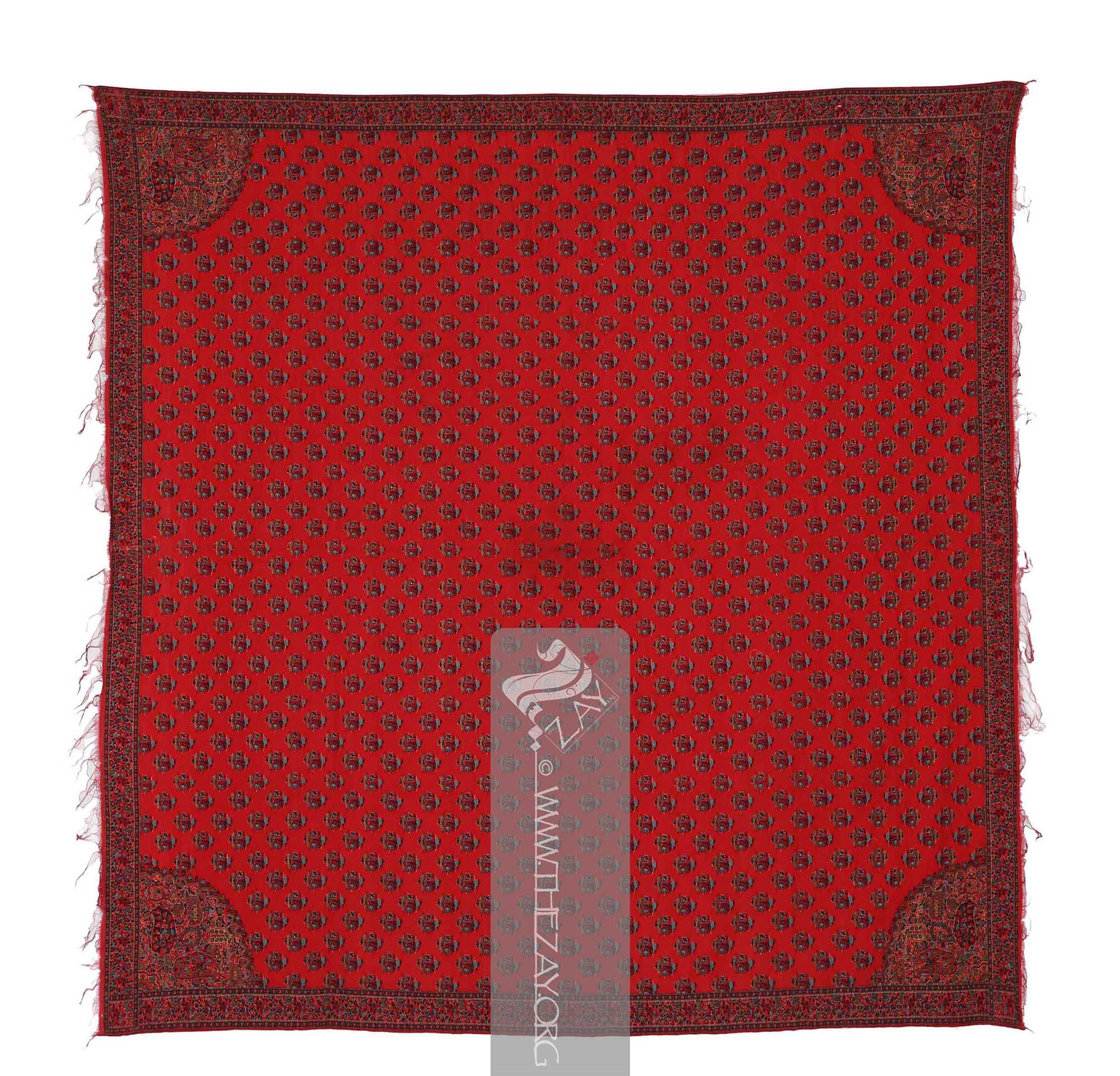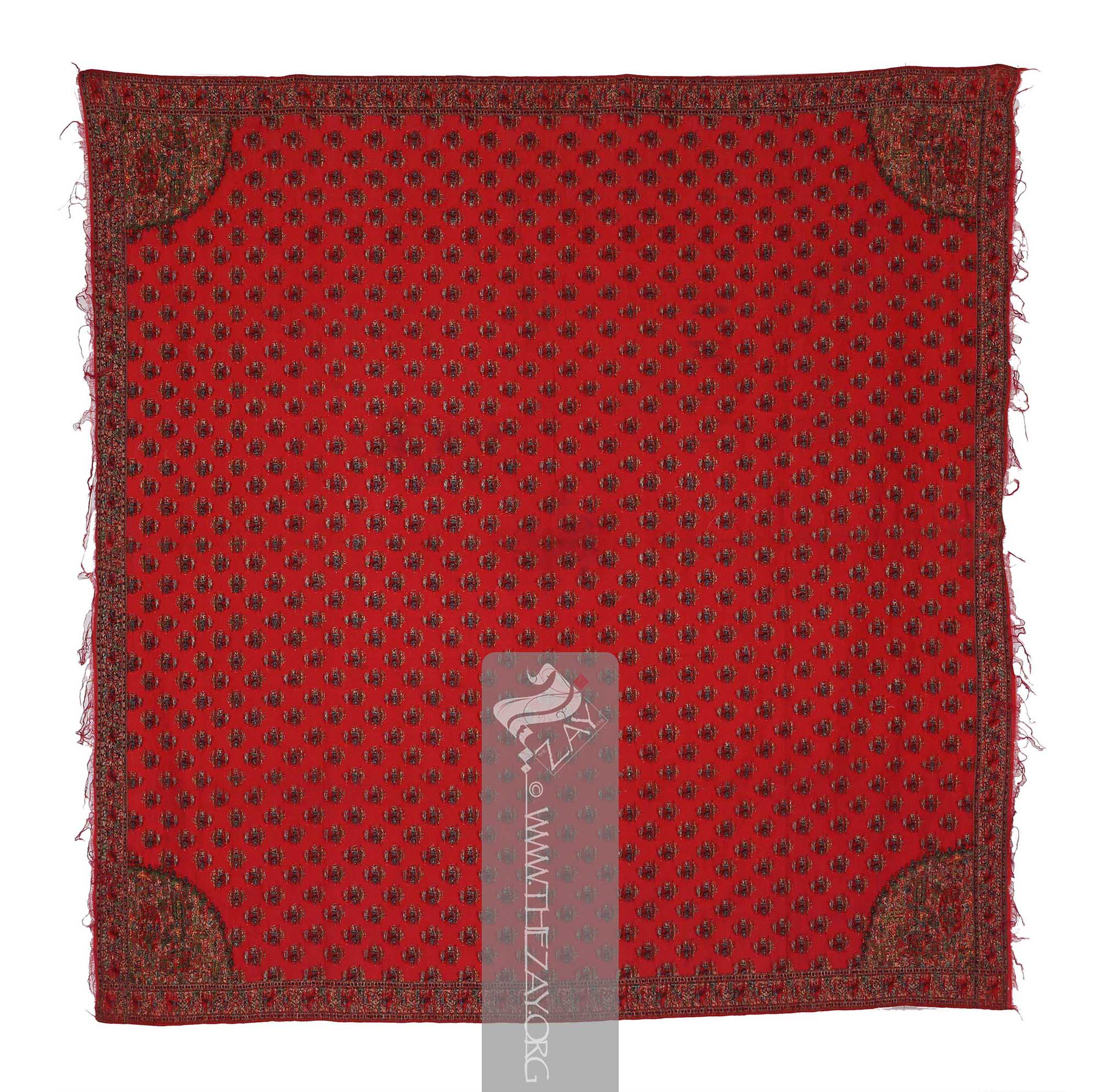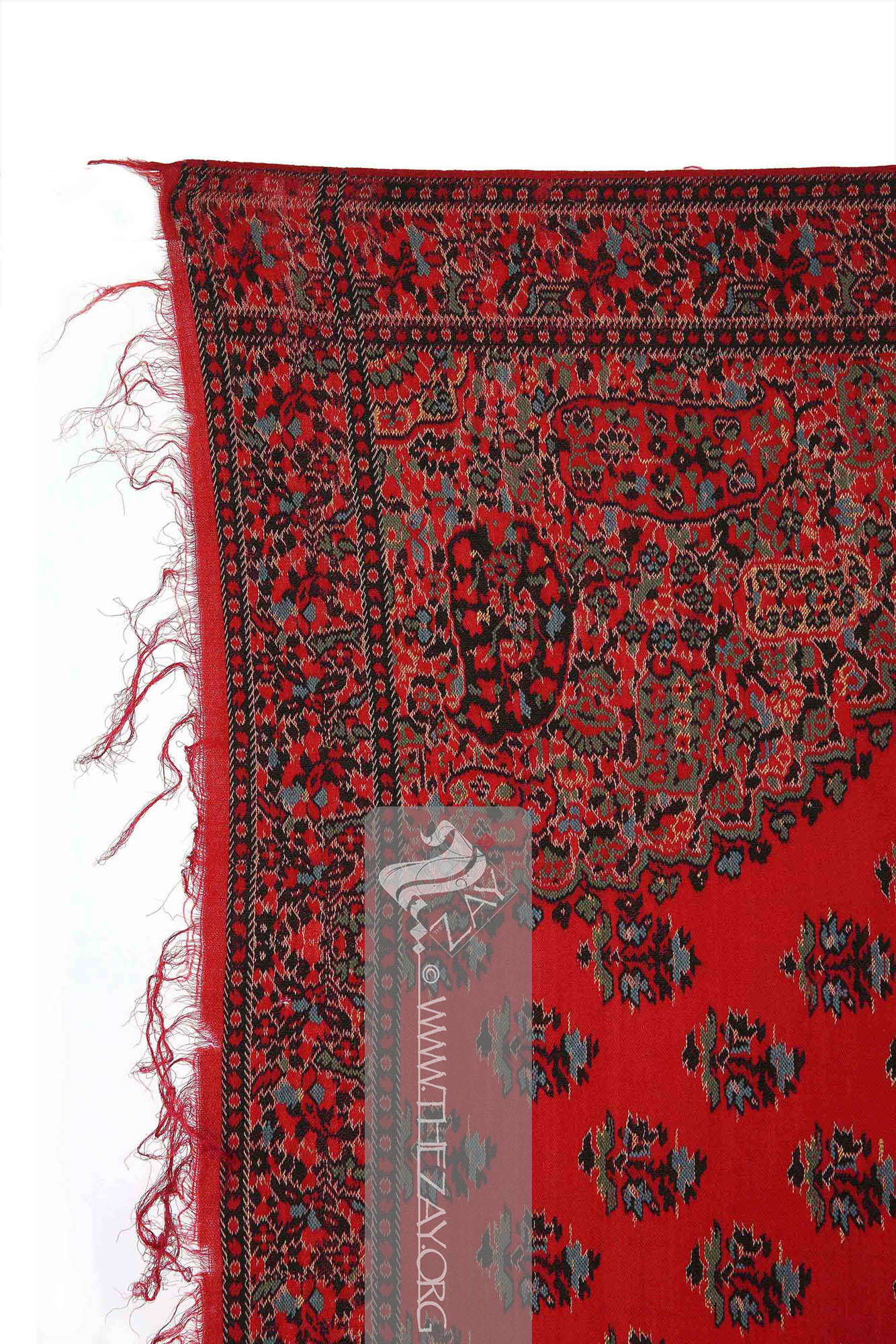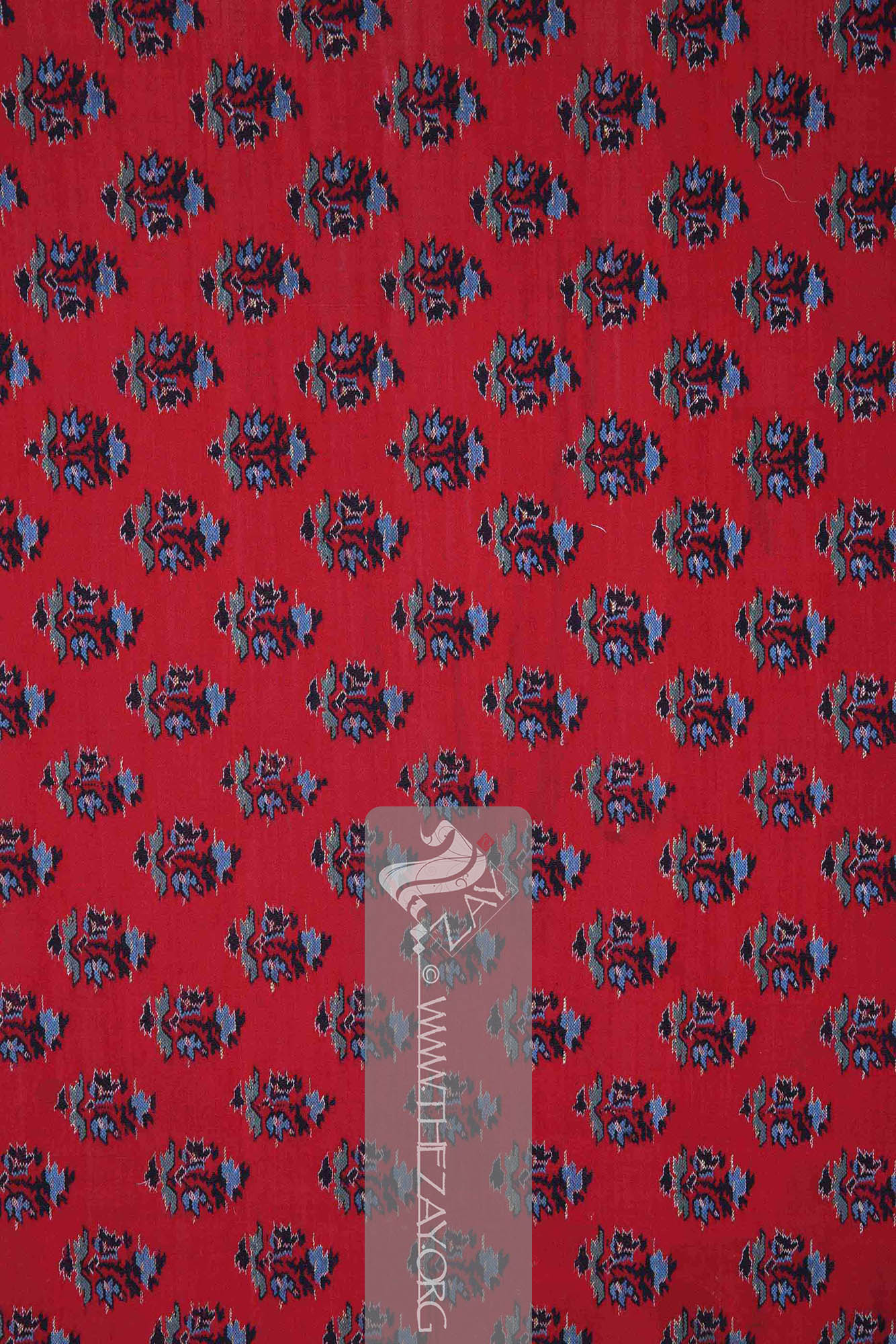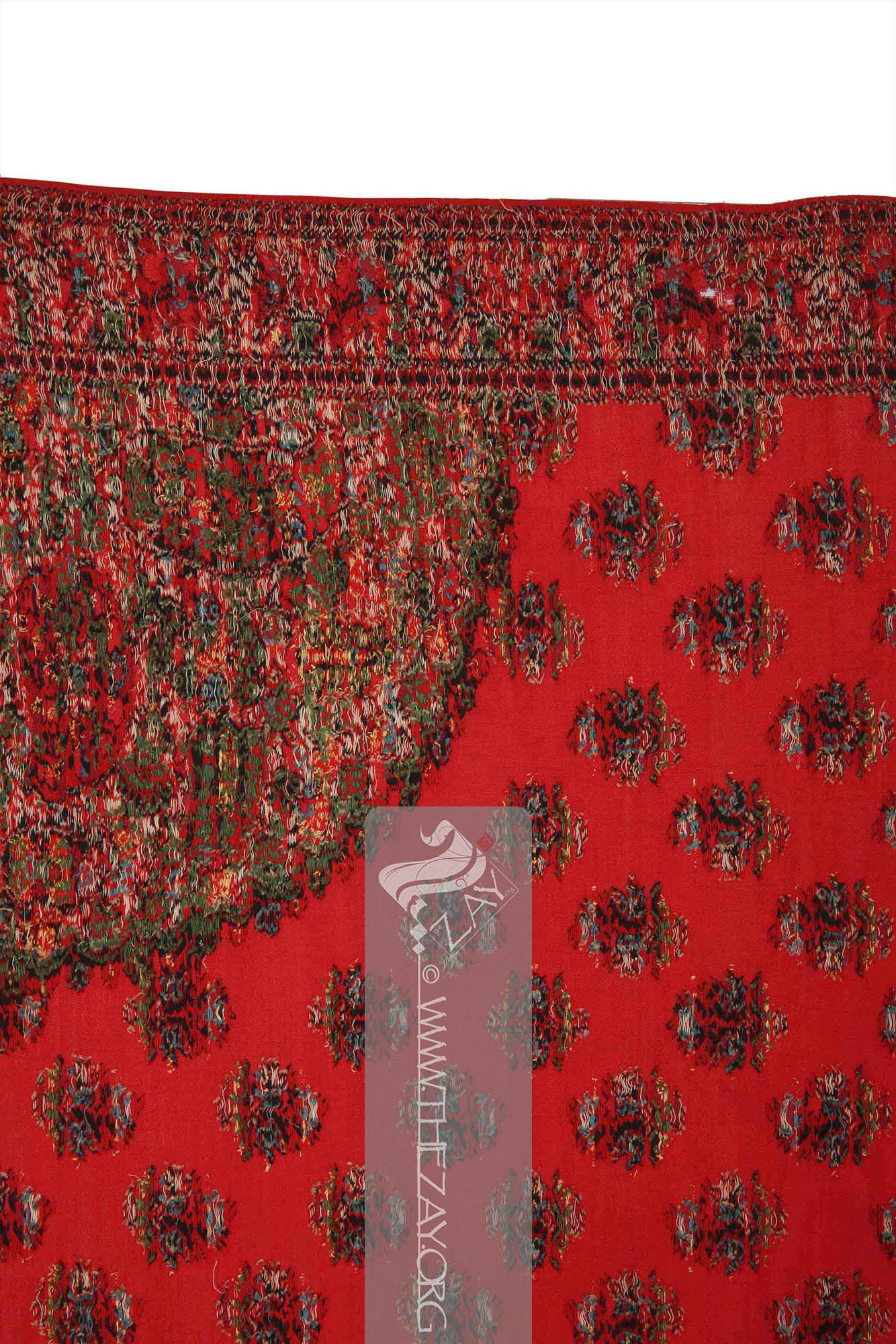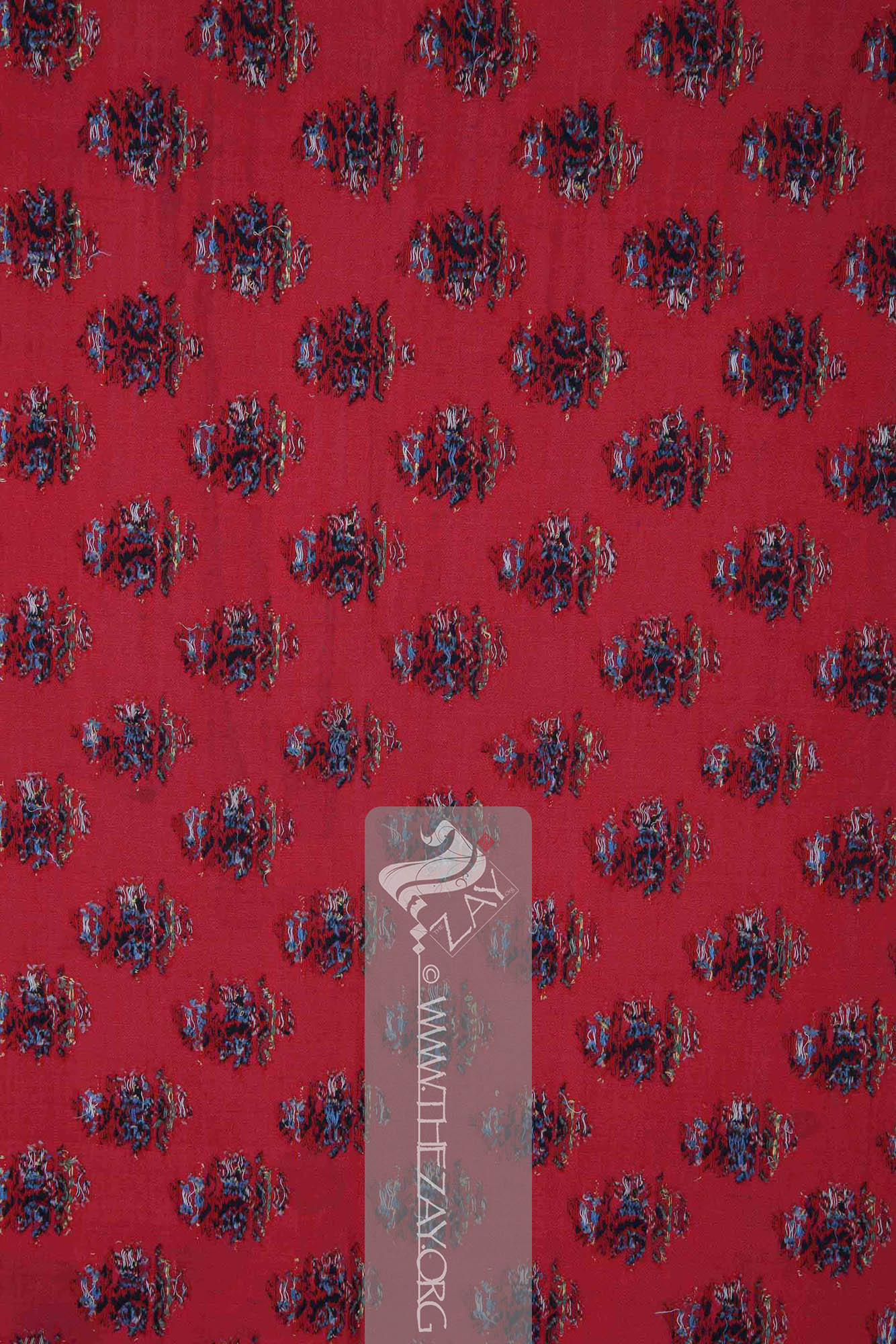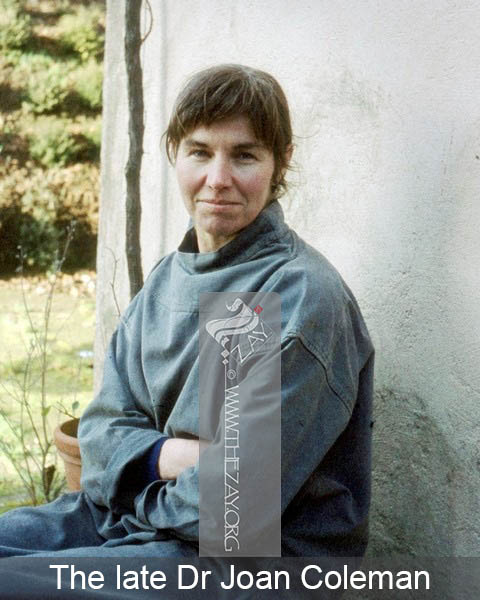Object HistoryThis red (
Paisley_shawl
Paisley_shawl: (Paisley: A town in Scotland), is a European version of a shawl in wool or silk, featuring the Persian buta motif. Inspired by contemporary Kashmir shawls, the town of Paisley first pioneered its manufacturing for the European market in the 18th century, thus becoming synonymous to the motif.) dating back to the first quarter of the 19th century was originally a part of the Dr Joan Coleman Collection. It was first purchased at an auction at Christie’s, London in 1976. Later The
Zay
Zay: (Arabic: costume, Pl. azyaā’), a set of clothes in a style typical of a particular country or historical period. Initiative managed to acquire it from Kerry Taylor Auctions in 2021.
Dr Joan Coleman began collecting shawls in 1976 and developed her lifelong passion for collecting. She was a regular at the London salesrooms of Christie’s, Sotheby’s, and Phillips – three of the most outstanding auction houses of the period in the world – getting to know the dealers and learning in the process. She acquired vast knowledge and dedicated hours carefully cataloguing her ever-growing collection. She intended to loan her collection to different museums and institutions for the benefit of learning and education. Her collection is one of the largest and the finest private
shawl
Shawl: (Persian: shāl from Hindi: duśālā – Shoulder Mantle), a shawl is a South Asian version of a scarf
Scarf: (English), usually a rectangular piece of cloth loosely worn over the shoulders, upper body and arms, and sometimes also over the head. worn or wrapped loosely over the shoulders and is usually made of wool. collections to have ever graced the world with shawls ranging from Kashmir,
Paisley
Paisley: (Scottish Gaelic, Pàislig: a town in Scotland), often called buta
Būta: (Anglicized Persian: boteh – Pinecone shaped motif), known as paisley in English it is the almond or pinecone-shaped motif, especially in textiles. It is believed to have originated from the Cyprus tree a Zoroastrian symbol for life and eternity. In the current Indian context, however, it simply means motif., boteh, amli, or kalgi in the subcontinent and kazuwah in Arabic, is a Persian tear drop motif with a curved end specially in textiles. Its popularity and subsequent local production in 18th century at Paisley are responsible for its nomenclature., Edinburgh, Norwich, France, and Iran.
Object Features This scarlet red rectangular
shawl
Shawl: (Persian: shāl from Hindi: duśālā – Shoulder Mantle), a shawl is a South Asian version of a scarf
Scarf: (English), usually a rectangular piece of cloth loosely worn over the shoulders, upper body and arms, and sometimes also over the head. worn or wrapped loosely over the shoulders and is usually made of wool. woven in a blend of silk and wool was probably made in
Paisley
Paisley: (Scottish Gaelic, Pàislig: a town in Scotland), often called buta
Būta: (Anglicized Persian: boteh – Pinecone shaped motif), known as paisley in English it is the almond or pinecone-shaped motif, especially in textiles. It is believed to have originated from the Cyprus tree a Zoroastrian symbol for life and eternity. In the current Indian context, however, it simply means motif., boteh, amli, or kalgi in the subcontinent and kazuwah in Arabic, is a Persian tear drop motif with a curved end specially in textiles. Its popularity and subsequent local production in 18th century at Paisley are responsible for its nomenclature. c. 1830s. Although identified as a square
shawl
Shawl: (Persian: shāl from Hindi: duśālā – Shoulder Mantle), a shawl is a South Asian version of a scarf
Scarf: (English), usually a rectangular piece of cloth loosely worn over the shoulders, upper body and arms, and sometimes also over the head. worn or wrapped loosely over the shoulders and is usually made of wool. by its previous owner, Kerry Taylor, later measurements prove that it is indeed rectangular in shape with its width just 2 cm shy of its length. This almost unnoticeable difference produces an illusion of a square shape.
The entire body of the
shawl
Shawl: (Persian: shāl from Hindi: duśālā – Shoulder Mantle), a shawl is a South Asian version of a scarf
Scarf: (English), usually a rectangular piece of cloth loosely worn over the shoulders, upper body and arms, and sometimes also over the head. worn or wrapped loosely over the shoulders and is usually made of wool. is filled with repeats of an angular floral sprig in (
turquoise
Turquoise: (French: turquois – present day Türkiye; Synonyms: firuze
Firuze: (Persian: pērōzah – "victory", later Arabic: fayrūz; Synonyms: firuze, pheroza), is a naturally occurring opaque mineral mined in abundance in Khorasan province of Iran and has been used for making dye for centuries. , pheroza), is a naturally occurring opaque mineral mined in abundance in Khorasan province of Iran and has been used for making dye for centuries. The term is a derivative of the French word for the country Türkiye once called Turkey. )/(
pheroza
: (Persian: pērōzah – "victory", later Arabic: fayrūz; Synonyms: firuze
Firuze: (Persian: pērōzah – "victory", later Arabic: fayrūz; Synonyms: firuze, pheroza), is a naturally occurring opaque mineral mined in abundance in Khorasan province of Iran and has been used for making dye for centuries. , turquoise
Turquoise: (French: turquois – present day Türkiye; Synonyms: firuze
Firuze: (Persian: pērōzah – "victory", later Arabic: fayrūz; Synonyms: firuze, pheroza), is a naturally occurring opaque mineral mined in abundance in Khorasan province of Iran and has been used for making dye for centuries. , pheroza), is a naturally occurring opaque mineral mined in abundance in Khorasan province of Iran and has been used for making dye for centuries. The term is a derivative of the French word for the country Türkiye once called Turkey. ), is a naturally occurring opaque mineral mined in abundance in Khorasan province of Iran and has been used for making dye for centuries. ), black, and olive green. Each corner of the
shawl
Shawl: (Persian: shāl from Hindi: duśālā – Shoulder Mantle), a shawl is a South Asian version of a scarf
Scarf: (English), usually a rectangular piece of cloth loosely worn over the shoulders, upper body and arms, and sometimes also over the head. worn or wrapped loosely over the shoulders and is usually made of wool. is embellished with a quadrant filled with angular (
paisley
Paisley: (Scottish Gaelic, Pàislig: a town in Scotland), often called buta
Būta: (Anglicized Persian: boteh – Pinecone shaped motif), known as paisley in English it is the almond or pinecone-shaped motif, especially in textiles. It is believed to have originated from the Cyprus tree a Zoroastrian symbol for life and eternity. In the current Indian context, however, it simply means motif., boteh, amli, or kalgi in the subcontinent and kazuwah in Arabic, is a Persian tear drop motif with a curved end specially in textiles. Its popularity and subsequent local production in 18th century at Paisley are responsible for its nomenclature.)/(
buta
Būta: (Anglicized Persian: boteh – Pinecone shaped motif), known as paisley in English it is the almond or pinecone-shaped motif, especially in textiles. It is believed to have originated from the Cyprus tree a Zoroastrian symbol for life and eternity. In the current Indian context, however, it simply means motif.) motifs in green, black, and
turquoise
Turquoise: (French: turquois – present day Türkiye; Synonyms: firuze
Firuze: (Persian: pērōzah – "victory", later Arabic: fayrūz; Synonyms: firuze, pheroza), is a naturally occurring opaque mineral mined in abundance in Khorasan province of Iran and has been used for making dye for centuries. , pheroza), is a naturally occurring opaque mineral mined in abundance in Khorasan province of Iran and has been used for making dye for centuries. The term is a derivative of the French word for the country Türkiye once called Turkey. with beige highlights. A thick border running around the edge of the piece is also composed of similar floral design elements. Repeats of a floral motif in beige and red alternately arranged in a thin black line runs along the thick border on both top and bottom.
Its (
selvedge
Selvedge: (English: Self-finished edge or self-edge: a dialect forming transition), an edge produced on woven fabric during manufacture that prevents it from unravelling. Traditionally the term selvage applied to only loom woven fabric, presently it could be applied to flat knitted fabric too. ) to
selvedge
Selvedge: (English: Self-finished edge or self-edge: a dialect forming transition), an edge produced on woven fabric during manufacture that prevents it from unravelling. Traditionally the term selvage applied to only loom woven fabric, presently it could be applied to flat knitted fabric too. weave testifies to its (
jacquard
Jacquard: (After Joseph M Jacquard a French weaver and inventor), is referred to both an apparatus with perforated cards invented by the aforementioned Joseph M Jacquard in 1804 fitted to a loom enabling complex intricate weaving patterns and the brocaded fabric woven on a jacquard loom. ) origin with its (
weft
Weft: one of the two basic components used in weaving that transforms thread or yarns into a piece of fabric. It is the crosswise thread on a loom that is passed over and under the warp threads.) ends flaunting a series of loose hanging threads as fringes.
Links
- Irwin, John. The Kashmir Shawls. Her Majesty's Stationary Office, 1981.
- Thornton, Zita. "The Norwich Shawl
Shawl: (Persian: shāl from Hindi: duśālā – Shoulder Mantle), a shawl is a South Asian version of a scarf
Scarf: (English), usually a rectangular piece of cloth loosely worn over the shoulders, upper body and arms, and sometimes also over the head. worn or wrapped loosely over the shoulders and is usually made of wool. ." Antiques Info, vol. 4, 2001, http://www.antiques-info.co.uk/new/pdf/Mar01/4.pdf
- Hoyt, Helen, et al. "Norwich Shawl
Shawl: (Persian: shāl from Hindi: duśālā – Shoulder Mantle), a shawl is a South Asian version of a scarf
Scarf: (English), usually a rectangular piece of cloth loosely worn over the shoulders, upper body and arms, and sometimes also over the head. worn or wrapped loosely over the shoulders and is usually made of wool. ." Costume and Textile Association: Miscellany, 2016, https://www.ctacostume.org.uk/uploads/1/1/9/5/119530260/miscellany_2016_web__1_.pdf
- Skarratt, Ben. "From India to Europe: The Production of the Kashmir Shawl
Shawl: (Persian: shāl from Hindi: duśālā – Shoulder Mantle), a shawl is a South Asian version of a scarf
Scarf: (English), usually a rectangular piece of cloth loosely worn over the shoulders, upper body and arms, and sometimes also over the head. worn or wrapped loosely over the shoulders and is usually made of wool. and the Spread of the Paisley
Paisley: (Scottish Gaelic, Pàislig: a town in Scotland), often called buta
Būta: (Anglicized Persian: boteh – Pinecone shaped motif), known as paisley in English it is the almond or pinecone-shaped motif, especially in textiles. It is believed to have originated from the Cyprus tree a Zoroastrian symbol for life and eternity. In the current Indian context, however, it simply means motif., boteh, amli, or kalgi in the subcontinent and kazuwah in Arabic, is a Persian tear drop motif with a curved end specially in textiles. Its popularity and subsequent local production in 18th century at Paisley are responsible for its nomenclature. Motif." Global History of Capitalism, University of Oxford, 2018, https://globalcapitalism.history.ox.ac.uk/sites/default/files/globalcapitalism/documents/media/case_04_-_the_paisley_0.pdf
- Sethi, Ritu. Handmade for the 21st Century: Safeguarding Traditional Indian Textiles. UNESCO, 2022.
- Quaile, Sheilagh Dr. "Cashmere
Cashmere: (Anglisized from Hindustani: Kashmir – A region or province in the Indian subcontinent), a fine soft natural wool, from the hair of goats native to the Kashmir, Ladakh and neighbouring regions of the Indian subcontinent. Often confused with Pashmina, it should be noted that all cashmeres are not pashmina. Shawls." Khan Academy, www.khanacademy.org/humanities/art-asia/south-asia/x97ec695a:1500-1850-deccan-south/a/cashmere
Cashmere: (Anglisized from Hindustani: Kashmir – A region or province in the Indian subcontinent), a fine soft natural wool, from the hair of goats native to the Kashmir, Ladakh and neighbouring regions of the Indian subcontinent. Often confused with Pashmina, it should be noted that all cashmeres are not pashmina. -shawls
- Van Schoor, Jennifer Ann (2019) The Indian cashmere
Cashmere: (Anglisized from Hindustani: Kashmir – A region or province in the Indian subcontinent), a fine soft natural wool, from the hair of goats native to the Kashmir, Ladakh and neighbouring regions of the Indian subcontinent. Often confused with Pashmina, it should be noted that all cashmeres are not pashmina. shawl
Shawl: (Persian: shāl from Hindi: duśālā – Shoulder Mantle), a shawl is a South Asian version of a scarf
Scarf: (English), usually a rectangular piece of cloth loosely worn over the shoulders, upper body and arms, and sometimes also over the head. worn or wrapped loosely over the shoulders and is usually made of wool. and social status in British art, 1760-1870. [Thesis] (Unpublished) https://eprints.bbk.ac.uk/id/eprint/40406/1/VAN%20SCHOOR%20J.A.%20–%20PHD%202019-vol%201.pdf
- Andrew Newey, “Cashmere
Cashmere: (Anglisized from Hindustani: Kashmir – A region or province in the Indian subcontinent), a fine soft natural wool, from the hair of goats native to the Kashmir, Ladakh and neighbouring regions of the Indian subcontinent. Often confused with Pashmina, it should be noted that all cashmeres are not pashmina. Country: The Perils of Making the World’s Finest Fabric,” The Guardian (10 January 2020), https://www.theguardian.com/environment/2020/jan/10/cashmere
Cashmere: (Anglisized from Hindustani: Kashmir – A region or province in the Indian subcontinent), a fine soft natural wool, from the hair of goats native to the Kashmir, Ladakh and neighbouring regions of the Indian subcontinent. Often confused with Pashmina, it should be noted that all cashmeres are not pashmina. -country-the-perils-of-making-the-worlds-finest-fabric
- Zutshi, Chitralekha. "Designed for Eternity: Kashmiri
Kashmiri: (Hindustani: Kashmir – a region in South Asia), a term used to denote or identify anything related to the region – its people, their language, culture, art and craft, society etc. Shawls, Empire, and Cultures of Production and Consumption in Mid-Victorian Britain." The Journal of British Studies, vol. 48, no. 2, 2009,https://www.cambridge.org/core/journals/journal-of-british-studies/article/abs/designed-for-eternity-kashmiri
Kashmiri: (Hindustani: Kashmir – a region in South Asia), a term used to denote or identify anything related to the region – its people, their language, culture, art and craft, society etc. -shawls-empire-and-cultures-of-production-and-consumption-in-midvictorian-britain/8BC637E16F9C0009A4A8097114FC630F
- A Moon Shawl
Shawl: (Persian: shāl from Hindi: duśālā – Shoulder Mantle), a shawl is a South Asian version of a scarf
Scarf: (English), usually a rectangular piece of cloth loosely worn over the shoulders, upper body and arms, and sometimes also over the head. worn or wrapped loosely over the shoulders and is usually made of wool. (Chandar
Chāndar: (Hindustani: chānd – moon; dar – derivative of chadar – a mantle or a covering; Synonym: Moon_shawl), were originally luxurious hand-woven shawls that originated in 17th century Kashmir and were characterized by a central circular medallion in an otherwise plain square field with four quarter medallions one in each corner. ), Christie’s, https://onlineonly.christies.com/s/important-private-collection-kashmir-shawls/moon-shawl
Shawl: (Persian: shāl from Hindi: duśālā – Shoulder Mantle), a shawl is a South Asian version of a scarf
Scarf: (English), usually a rectangular piece of cloth loosely worn over the shoulders, upper body and arms, and sometimes also over the head. worn or wrapped loosely over the shoulders and is usually made of wool. -chandar
Chāndar: (Hindustani: chānd – moon; dar – derivative of chadar – a mantle or a covering; Synonym: Moon_shawl), were originally luxurious hand-woven shawls that originated in 17th century Kashmir and were characterized by a central circular medallion in an otherwise plain square field with four quarter medallions one in each corner. -7/71406
- A Double Sided Long Shawl
Shawl: (Persian: shāl from Hindi: duśālā – Shoulder Mantle), a shawl is a South Asian version of a scarf
Scarf: (English), usually a rectangular piece of cloth loosely worn over the shoulders, upper body and arms, and sometimes also over the head. worn or wrapped loosely over the shoulders and is usually made of wool. (Dorukha), Christie’s, https://onlineonly.christies.com/s/important-private-collection-kashmir-shawls/double-sided-long-shawl
Shawl: (Persian: shāl from Hindi: duśālā – Shoulder Mantle), a shawl is a South Asian version of a scarf
Scarf: (English), usually a rectangular piece of cloth loosely worn over the shoulders, upper body and arms, and sometimes also over the head. worn or wrapped loosely over the shoulders and is usually made of wool. -doruka-1/71402
- A Kashmir Paisley
Paisley: (Scottish Gaelic, Pàislig: a town in Scotland), often called buta
Būta: (Anglicized Persian: boteh – Pinecone shaped motif), known as paisley in English it is the almond or pinecone-shaped motif, especially in textiles. It is believed to have originated from the Cyprus tree a Zoroastrian symbol for life and eternity. In the current Indian context, however, it simply means motif., boteh, amli, or kalgi in the subcontinent and kazuwah in Arabic, is a Persian tear drop motif with a curved end specially in textiles. Its popularity and subsequent local production in 18th century at Paisley are responsible for its nomenclature. Shawl
Shawl: (Persian: shāl from Hindi: duśālā – Shoulder Mantle), a shawl is a South Asian version of a scarf
Scarf: (English), usually a rectangular piece of cloth loosely worn over the shoulders, upper body and arms, and sometimes also over the head. worn or wrapped loosely over the shoulders and is usually made of wool. , Christie’s, https://onlineonly.christies.com/s/collection-paul-f-walter/kashmir-paisley
Paisley: (Scottish Gaelic, Pàislig: a town in Scotland), often called buta
Būta: (Anglicized Persian: boteh – Pinecone shaped motif), known as paisley in English it is the almond or pinecone-shaped motif, especially in textiles. It is believed to have originated from the Cyprus tree a Zoroastrian symbol for life and eternity. In the current Indian context, however, it simply means motif., boteh, amli, or kalgi in the subcontinent and kazuwah in Arabic, is a Persian tear drop motif with a curved end specially in textiles. Its popularity and subsequent local production in 18th century at Paisley are responsible for its nomenclature.-shawl
Shawl: (Persian: shāl from Hindi: duśālā – Shoulder Mantle), a shawl is a South Asian version of a scarf
Scarf: (English), usually a rectangular piece of cloth loosely worn over the shoulders, upper body and arms, and sometimes also over the head. worn or wrapped loosely over the shoulders and is usually made of wool. -616/46985
- Eastaugh, Nicky. "Norwich Shawls: Past Glory, Present Inspiration." Nicky Eastaugh's Learning Log for Textiles, 14 Oct. 2016, nickyeastaughmixedmediafortextiles.wordpress.com/2016/10/19/norwich-shawls-past-glory-present-inspiration-14-october-2016/.




